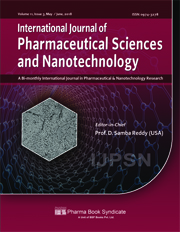Design and Optimization of Hydrophilic Matrix-based Sustained Release Felodipine Tablets
DOI:
https://doi.org/10.37285/ijpsn.2018.11.3.8Abstract
Felodipine is a calcium channel blocker used for hypertensive and unstable angina treatments. The sustained release formulations of felodipine have advantages of achieving good therapeutic effects, increasing the bioavailability, decreasing dosing times per day and reducing side effects.The aim of our study was to study the formulation screening, then use an experiment design for formulating a hydrophilic matrix sustained release tablet of felodipine. Methods: The optimization process had the influences of the chosen excipients (including HPMC E4M, HPMC E15LV) on the drug release. Three dependent variables were percentages of released felodipine at the sampling times 2h, 6h, 10h (Y2, Y6, Y10, respectively). Results: The release profile from the optimized formula almost met the predicted release profile and was similar to reference tablets. The kinetics of drug release the optimized tablets and reference tablets were also followed the Korsmeyer – Peppas model.Conclusion: The optimized formula was obtained, and the in vitro release profile was similar to the predicted profile and reference tablets.
Downloads
Metrics
Keywords:
Felodipine, Solid dispersion system, HPMC, Sustained-release, Hydrophilic matrixDownloads
Published
How to Cite
Issue
Section
References
Karavas E, G. Ktistis, A. Xenakis and E. Georgarakis (2006). Effect of hydrogen bonding interactions on the release mechanism of felodipine from nanodispersions with polyvinylpyrrolidone. Eur J Pharmaceutics & Biopharmaceutics 63(2): 103-114.
Kumar SK, T. Ramarao, D. Bikshapathi and K. Jayaveera (2013). Controlled release formulation development and evaluation of felodipine matrix tablets by using hydrophobic polymers." Int J Pharm Sci & Res 4(1): 506.
Lee KR., E.-J. Kim, S.-W. Seo and H.-K. Choi (2008). Effect of poloxamer on the dissolution of felodipine and preparation of controlled release matrix tablets containing felodipine. Arch Pharmacol Res 31(8): 1023-1028.
Lee KK., D. S. Lee, Y. S. Rhee, J. H. Jang, S. O. Jeoung and S. J. Kim (2003). Controlled release composition comprising felodipine and method of preparation thereof, Google Patents.
USP (2011). United States Pharmacopeial Convention. Felodipine Extended - Realease Tablets. USP 34 - NF p.2113.






